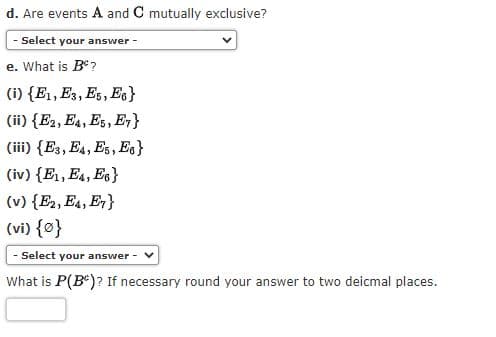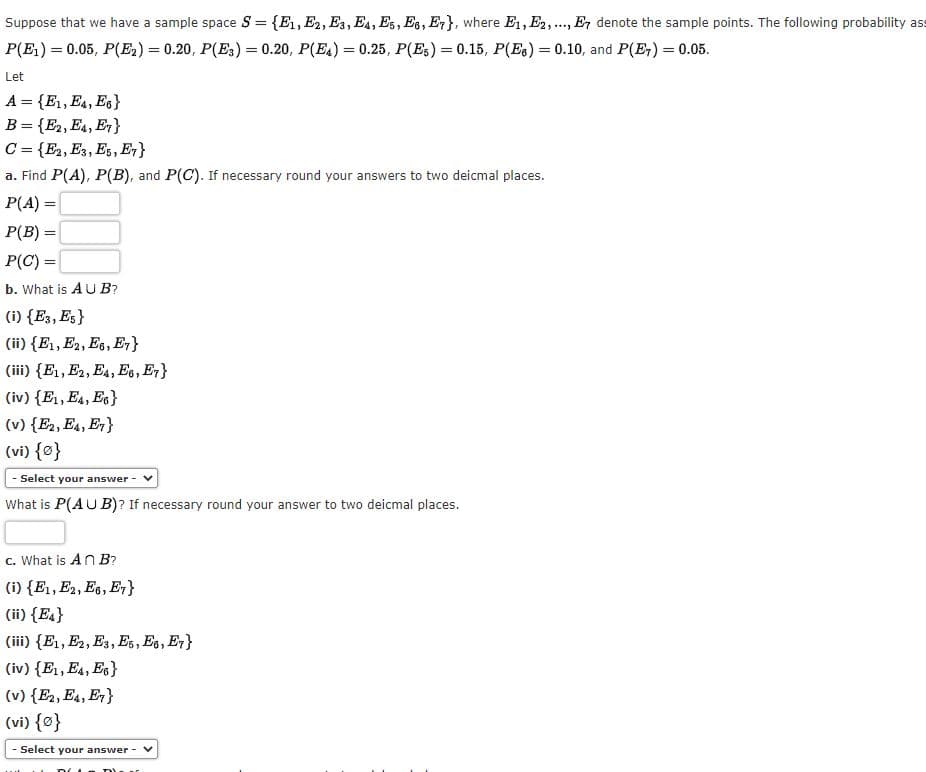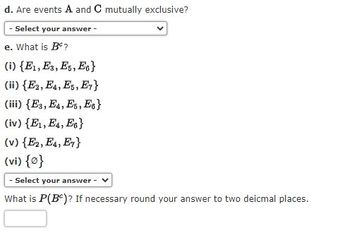Suppose that we have a sample space S = {E1, E2, E3, E4, E5, E6, E7}, where E1, E2,..., E7 denote the sample points. The following probability ass P(E₁)= 0.05, P(E2) = 0.20, P(E3) = 0.20, P(E4) = 0.25, P(ES) = 0.15, P(EB) = 0.10, and P(E7) = 0.05. Let A = {E1, E4, E6} B = {E2, E4, E7} C= {E2, E3, E5, E7} a. Find P(A), P(B), and P(C). If necessary round your answers to two deicmal places. P(A) = P(B) = P(C)= b. What is AU B? (i) {E3, E5} (ii) {E1, E2, E6, E7} (iii) {E1, E2, E4, E6, E7} (iv) {E₁, E4, E6} (v) {E2, E4, E7} (vi) {0} - Select your answer - ✓ What is P(AUB)? If necessary round your answer to two deicmal places. c. What is An B? (i) {E1, E2, E6, E7} (ii) {E4} (iii) {E1, E2, E3, E5, E6, E7} (iv) {E1, E4, E6} (v) {E2, E4, E7} (vi) {0} - Select your answer - DO D
Suppose that we have a sample space S = {E1, E2, E3, E4, E5, E6, E7}, where E1, E2,..., E7 denote the sample points. The following probability ass P(E₁)= 0.05, P(E2) = 0.20, P(E3) = 0.20, P(E4) = 0.25, P(ES) = 0.15, P(EB) = 0.10, and P(E7) = 0.05. Let A = {E1, E4, E6} B = {E2, E4, E7} C= {E2, E3, E5, E7} a. Find P(A), P(B), and P(C). If necessary round your answers to two deicmal places. P(A) = P(B) = P(C)= b. What is AU B? (i) {E3, E5} (ii) {E1, E2, E6, E7} (iii) {E1, E2, E4, E6, E7} (iv) {E₁, E4, E6} (v) {E2, E4, E7} (vi) {0} - Select your answer - ✓ What is P(AUB)? If necessary round your answer to two deicmal places. c. What is An B? (i) {E1, E2, E6, E7} (ii) {E4} (iii) {E1, E2, E3, E5, E6, E7} (iv) {E1, E4, E6} (v) {E2, E4, E7} (vi) {0} - Select your answer - DO D
College Algebra
7th Edition
ISBN:9781305115545
Author:James Stewart, Lothar Redlin, Saleem Watson
Publisher:James Stewart, Lothar Redlin, Saleem Watson
Chapter9: Counting And Probability
Section9.3: Binomial Probability
Problem 2E: If a binomial experiment has probability p success, then the probability of failure is...
Related questions
Question

Transcribed Image Text:d. Are events A and C mutually exclusive?
- Select your answer -
e. What is Bº?
(i) {E1, E3, E5, E6}
(ii) {E2, E4, E5, E7}
(iii) {E3, E4, E5, Es}
(iv) {E₁, E4, E6}
(v) {E2, E4, E7}
(vi) {0}
- Select your answer -
What is P(B)? If necessary round your answer to two deicmal places.

Transcribed Image Text:Suppose that we have a sample space S = {E1, E2, E3, E4, E5, E6, E7}, where E1, E2,..., E7 denote the sample points. The following probability ass
P(E₁)= 0.05, P(E2) = 0.20, P(E3) = 0.20, P(E4) = 0.25, P(ES) = 0.15, P(EB) = 0.10, and P(E7) = 0.05.
Let
A = {E1, E4, E6}
B = {E2, E4, E7}
C= {E2, E3, E5, E7}
a. Find P(A), P(B), and P(C). If necessary round your answers to two deicmal places.
P(A) =
P(B) =
P(C)=
b. What is AU B?
(i) {E3, E5}
(ii) {E1, E2, E6, E7}
(iii) {E1, E2, E4, E6, E7}
(iv) {E₁, E4, E6}
(v) {E2, E4, E7}
(vi) {0}
- Select your answer - V
What is P(AUB)? If necessary round your answer to two deicmal places.
c. What is An B?
(i) {E1, E2, E6, E7}
(ii) {E4}
(iii) {E1, E2, E3, E5, E6, E7}
(iv) {E₁, E4, E6}
(v) {E2, E4, E7}
(vi) {0}
- Select your answer -
DO D
Expert Solution
This question has been solved!
Explore an expertly crafted, step-by-step solution for a thorough understanding of key concepts.
This is a popular solution!
Trending now
This is a popular solution!
Step by step
Solved in 3 steps with 2 images

Follow-up Questions
Read through expert solutions to related follow-up questions below.
Follow-up Question

Transcribed Image Text:d. Are events A and C mutually exclusive?
- Select your answer -
e. What is Bº?
(i) {E1, E3, E5, E6}
(ii) {E2, E4, E5, E7}
(iii) {E3, E4, E5, Es}
(iv) {E₁, E4, E6}
(v) {E2, E4, E7}
(vi) {0}
- Select your answer -
What is P(B)? If necessary round your answer to two deicmal places.
Solution
Recommended textbooks for you

College Algebra
Algebra
ISBN:
9781305115545
Author:
James Stewart, Lothar Redlin, Saleem Watson
Publisher:
Cengage Learning

Holt Mcdougal Larson Pre-algebra: Student Edition…
Algebra
ISBN:
9780547587776
Author:
HOLT MCDOUGAL
Publisher:
HOLT MCDOUGAL


College Algebra
Algebra
ISBN:
9781305115545
Author:
James Stewart, Lothar Redlin, Saleem Watson
Publisher:
Cengage Learning

Holt Mcdougal Larson Pre-algebra: Student Edition…
Algebra
ISBN:
9780547587776
Author:
HOLT MCDOUGAL
Publisher:
HOLT MCDOUGAL


Algebra & Trigonometry with Analytic Geometry
Algebra
ISBN:
9781133382119
Author:
Swokowski
Publisher:
Cengage